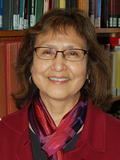The TLAM class recently learned a lot more about the development of tribal libraries in the United States by reading about Lotsee Patterson’s work that began in the 1970s1. With partners like Charles Townley and the support of the Bureau of Indian Affairs, Patterson helped to make Native-run libraries on tribal lands become a reality. She also helped to found the American Indian Library Association.
“It was an exciting time to be in library school,” Janice Rice, senior academic librarian at the University of Wisconsin-Madison’s College Library, shared with the class during her recent visit.

One can easily see Janice’s admiration for the work Patterson and her peers accomplished to set up libraries across the U.S. During this time Janice, a member of the Ho-Chunk Nation, had been pursuing a master’s degree in library science. Since then, Janice has also been involved in the American Indian Library Association, and like Patterson was at one time president of the association.
For the class, Janice briefly traced the history of American Indian libraries:
- Boarding schools era: an example was given about American Indian students maintaining and using libraries in residence halls at the Indian boarding school in Carlisle, Pa.
- 1970s: tribal libraries were created across the U.S. to meet the information needs of tribes and because of Patterson’s efforts
- 1980s: tribal college libraries were created for college accreditation
Janice explained how tribes, when planning their libraries, try to make their libraries relevant to their communities. The focus is on what’s most important to the tribe as a community, not the individual. And to look forward and think of future generations and their needs. Therefore, tribal libraries are integral to its communities once they’ve been planned and established. We see this evidence in the many roles a tribal library may play today: a public library, a tribal college library, a tribal archive, and/or a school library partner.
Connecting with other tribal libraries and librarians is an important part to building a tribal library community. It is from each other that we may discuss and build on best practices as it relates to our communities. There are tribal college librarian gatherings, Janice shared, and professional organizations like the aforementioned American Indian Library Association (http://ailanet.org). The AILA may be especially important to tribal libraries with limited budgets because members, for a small annual fee, may access a multitude of resources.
Janice concluded her visit with our class by providing a few interesting resources to the class to learn more about Native peoples and Tribal Libraries. These resources are listed below:
Tribal Libraries, a Selected Bibliography:
Midwest Alliance of Sovereign Tribes: http://m-a-s-t.org/
Map of U.S. Federal and State Indian Reservations: http://infoplease.com/images/indian9.gif
Other resources mentioned above include:
American Indian Library Association (http://ailanet.org)
-Mee Xiong
1Biggs, Bonnie. (2000). Bright Child of Oklahoma: Lotsee Patterson and the Development of America’s Tribal Libraries. American Indian Culture & Research Journal, 24(4), 55-67.
